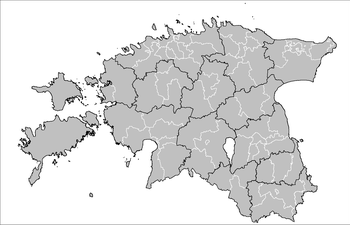County
A county is a geographical region of a country used for administrative or other purposes,[1] in certain modern nations. The term is derived from the Old French conté or cunté denoting a jurisdiction under the sovereignty of a count (earl) or a viscount.[2] The modern French is comté, and its equivalents in other languages are contea, contado, comtat, condado, Grafschaft, graafschap, Gau, etc. (compare conte, comte, conde, Graf).
When the Normans conquered England, they brought the term with them. The Saxons had already established the districts that became the historic counties of England, calling them shires;[3] many county names derive from the name of the county town (county seat) with the word shire added on: for example, Gloucestershire and Worcestershire.[4]
The Anglo-Saxon terms earl and earldom were taken as equivalent to the continental terms "count" and "county" under the conquering Normans, and over time the two blended and became equivalent. Further, the later-imported term became a synonym for the native Old English word sċīr ([ʃiːr]) or, in Modern English, shire. Since a shire was an administrative division of the kingdom, the term "county" evolved to designate an administrative division of a federal state, as in Germany and the United States, or of a national government in most other modern uses.
In the United States and Canada, founded 600 years later[lower-alpha 1] on the British traditions, counties are usually an administrative division set by convenient geographical demarcations, which in governance have certain officeholders (for example sheriffs and their departments) as a part of the state and provincial mechanisms, including geographically common court systems.[5]
A county may be further subdivided into districts, hundreds, townships or other administrative jurisdictions within the county. A county usually, but not always, contains cities, towns, townships, villages, or other municipal corporations, which in most cases are somewhat subordinate or dependent upon county governments. Depending on the nation, municipality, and local geography, municipalities may or may not be subject to direct or indirect county control — the functions of both levels are often consolidated into a city government when the area is densely populated.[lower-alpha 2]
Outside English-speaking countries, an equivalent of the term county is often used to describe subnational jurisdictions that are structurally equivalent to counties in the relationship they have with their national government;[lower-alpha 3] but which may not be administratively equivalent to counties in predominantly English-speaking countries.
Africa
Kenyan
Counties are the current second-level political division in Kenya. Each county has an assembly where members of the county assembly (MCAs) sit. This assembly is headed by a Governor. Each county is also represented in the Senate of Kenya by a senator. Additionally, a Women's Representative is elected from each county to the Parliament of Kenya to represent women's interests. Counties replaced provinces as the second-level division after the promulgation of the 2010 Constitution of Kenya.
Liberia
Liberia has 15 counties, each of which elects two senators to the Senate of Liberia.
The Americas
Argentina
Provinces in Argentina are divided into departments (Spanish: departamentos), except in the Buenos Aires Province, where they are called partidos. The Autonomous City of Buenos Aires is divided into communes (comunas).
Canada
Five of Canada's provinces – New Brunswick, Nova Scotia, Ontario, Quebec and Prince Edward Island – are divided into counties. In those older provinces that have a two-tier system of municipal government, the counties constitute the upper tier and local municipalities form the lower tier.
In addition to counties, Ontario is also subdivided (depending on population densities) into districts, one district municipality, and regional municipalities (the latter being restructurings of former counties). which are also part of the upper tier.
British Columbia has counties for the purposes of its justice system, but these counties otherwise have no governmental function. For the provision of all other governmental services, the province is divided into regional districts that form the upper tier. They are subdivided into local municipalities that are partly autonomous, and unincorporated electoral areas that are governed directly by the regional districts.
In Alberta, the term county is synonymous with the term municipal district – it is not its own incorporated municipal status that is different from that of a municipal district. As such, Alberta Municipal Affairs provides municipal districts with the opportunity to brand themselves either as municipal districts or counties in their official names.
A county in Alberta used to be a type of designation in a single-tier municipal system; but this was changed to "municipal district" under the Municipal Government Act, when the County Act was repealed in the mid-1990s, at which time they were also permitted to retain the usage of county in their official names.[6]
The rest of Canada has only one level of municipal government. Manitoba, Newfoundland and Labrador, Northwest Territories, Nunavut, Saskatchewan, and Yukon use their municipalities as regional and local subdivisions without any real differentiation between the two.
Jamaica
Jamaica is divided into 14 parishes which are grouped together into 3 historic counties: Cornwall, Middlesex, and Surrey.
United States
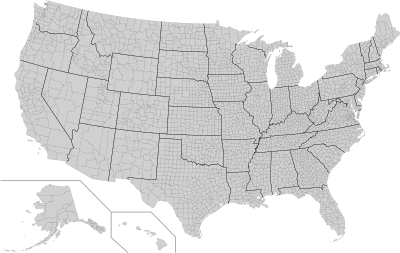
Counties in U.S. states are administrative or political subdivision of the state in which their boundaries are drawn. In addition, the United States Census Bureau uses the term "county equivalent" to describe places that are comparable to counties, but called by different names.[7] Today, 3,142 counties and county equivalents carve up the United States, ranging in number from 3 for Delaware to 254 for Texas.
Forty-eight of the 50 U.S. states use the term "county", while Alaska and Louisiana use the terms "borough" and "parish", respectively, for analogous jurisdictions. A consolidated city-county such as Philadelphia and San Francisco is formed when a city and county merges into one unified jurisdiction. Conversely, an independent city like Baltimore and St. Louis legally belongs to no county, i.e. no county even nominally exists in those places compared to a consolidated city-county where a county does legally exist in some form. The District of Columbia, outside the jurisdiction of any state, is viewed by the U.S. Census Bureau as a single county equivalent.[7]
The specific governmental powers of counties vary widely between the states. They are generally the intermediate tier of state government, between the statewide tier and the immediately local government tier (typically a city, town/borough or village/township). Some of the governmental functions that a county may offer include judiciary, county prisons, land registration, enforcement of building codes, federally mandated services programs. Depending on the individual state, counties or their equivalents may be administratively subdivided into townships, boroughs or boros, or towns (in the New England states, New York, Pennsylvania, and Wisconsin). For independent cities and consolidated city-counties, those places report directly to the state.
New York City is a special case where the city is made up of five boroughs, each of which is territorially coterminous with a county of New York State. In the context of city government, the boroughs are subdivisions of the city but are still called "county" where state function is involved, e.g., "New York County Courthouse".
County governments in Rhode Island and Connecticut have been completely abolished but the entities remain for administrative or statistical purposes. Alaska's 323,440-square-mile (837,700 km2) Unorganized Borough also has no county equivalent government, but the U.S. Census Bureau further divides it into statistical county equivalent subdivisions called census areas.[7]
The areas of each county also vary widely between the states. For example, the territorially medium-sized state of Pennsylvania has 67 counties delineated in geographically convenient ways.[8] By way of contrast, Massachusetts, with far less territory, has massively sized counties in comparison even to Pennsylvania's largest,[lower-alpha 4] yet each organizes their judicial and incarceration officials similarly.
Most counties have a county seat: a city, town, or other named place where its administrative functions are centered. Some New England states use the term shire town to mean "county seat". A handful of counties like Harrison County, Mississippi have two or more county seats, usually located on opposite sides of the county, dating back from the days when travel was difficult.
Asia–Pacific
Australia
In the eastern states of Australia, counties are used in the administration of land titles. They do not generally correspond to a level of government, but are used in the identification of parcels of land.
People's Republic of China
The word county is used to translate the Chinese term xiàn (县 or 縣). In Mainland China, governed by the People's Republic of China (PRC), counties are the third level of local government, coming under both the province level and the prefecture level.
There are 1,464 counties in the PRC out of 2,862 county-level divisions. The number of counties has remained more or less constant since the Han dynasty (206 BC – AD 220). The county remains one of the oldest levels of government in China and significantly predates the establishment of provinces in the Yuan dynasty (1279–1368). The county government was particularly important in imperial China because this was the lowest layer at which the imperial government functioned. The head of a county during imperial times was the magistrate.
In older context, district was an older English translation of xiàn before the establishment of the Republic of China (ROC). The English nomenclature county was adopted following the establishment of the ROC.
During most of the imperial era, there were no concepts like municipalities in China. All cities existed within counties, commanderies, prefectures, etc., and had no governments of their own.[9] Large cities (must be imperial capitals or seats of prefectures) could be divided and administered by two or three counties. Such counties are called 倚郭縣 (yǐguō xiàn, 'county leaning on the city walls') or 附郭縣 (fùguō xiàn, 'county attached to the city walls'). The yamen or governmental houses of these counties exist in the same city. In other words, they share one county town. In this sense, a yǐguō xiàn or fùguō xiàn is similar to a district of a city.
For example, the city of Guangzhou (seat of the eponymous prefecture, also known as Canton in the Western world) was historically divided by Nanhai County (南海縣) and Panyu County (番禺縣). When the first modern city government in China was established in Guangzhou, the urban area was separated from these two counties, with the rural areas left in the remaining parts of them. However, the county governments remained in the city for years, before moving into the respective counties. Similar processes happened in many Chinese cities.
Nowadays, most counties in mainland China are administered by prefecture-level cities. However, they are all rural areas, and no longer serve as urban districts.
Iran
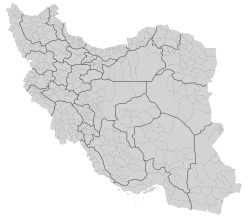
The ostans (provinces) of Iran are further subdivided into counties called shahrestān (Persian: شهرستان). County consists of a city centre, a few bakhsh (Persian: بخش), and many villages around them. There are usually a few cities (Persian: شهر, shahar) and rural agglomerations (Persian: دهستان, dehestān) in each county. Rural agglomerations are a collection of a number of villages. One of the cities of the county is appointed as the capital of the county.
Each shahrestān has a government office known as farmândâri (فرمانداری), which coordinates different events and government offices. The farmândâr فرماندار, or the head of farmândâri, is the governor of the shahrestān.
Fars Province has the highest number of shahrestāns, with 23, while Semnān and South Khorasan have only 4 shahrestāns each; Qom uniquely has one, being coextensive with its namesake county. Iran had 324 shahrestāns in 2005.
Korea
County is the common English translation for the character 군 (gun or kun) that denotes the current second level political division in South Korea and one type of municipal-level division in North Korea.
New Zealand
After New Zealand abolished its provinces in 1876, a system of counties similar to other countries' systems was instituted, lasting until 1989. They had chairmen, not mayors as boroughs and cities had; many legislative provisions (such as burial and land subdivision control) were different for the counties.
During the second half of the 20th century, many counties received overflow population from nearby cities. The result was often a merger of the two into a district (e.g. Rotorua) or a change of name to either district (e.g. Waimairi) or city (e.g. Manukau City).
The Local Government Act 1974 began the process of bringing urban, mixed, and rural councils into the same legislative framework. Substantial reorganisations under that Act resulted in the 1989 shake-up, which covered the country in (non-overlapping) cities and districts and abolished all the counties except for the Chatham Islands County, which survived under that name for a further 6 years but then became a "Territory" under the "Chatham Islands Council".
Taiwan
County is the common English translation for the character 縣 (Wade–Giles: hsien4) that denotes the current first level political division in Taiwan and surrounding islands. However, provincial cities have the same level of authority as counties. Above county, there are special municipalities (in effect) and province (suspended due to economical and political reasons). There are currently 14 counties in Taiwan.
Europe
Denmark
Denmark was divided into counties (Danish: amter) from 1662 to 2006. On 1 January 2007 the counties were replaced by five Regions. At the same time, the number of municipalities was slashed to 98.
The counties were first introduced in 1662, replacing the 49 fiefs (len) in Denmark–Norway with the same number of counties. This number does not include the subdivisions of the Duchy of Schleswig, which was only under partial Danish control. The number of counties in Denmark (excluding Norway) had dropped to around 20 by 1793. Following the reunification of South Jutland with Denmark in 1920, four counties replaced the Prussian Kreise. Aabenraa and Sønderborg County merged in 1932 and Skanderborg and Aarhus were separated in 1942. From 1942 to 1970, the number stayed at 22.[10] The number was further decreased by the 1970 Danish municipal reform, leaving 14 counties plus two cities unconnected to the county structure; Copenhagen and Frederiksberg.
In 2003, Bornholm County merged with the local five municipalities, forming the Bornholm Regional Municipality. The remaining 13 counties were abolished on 1 January 2007 where they were replaced by five new regions. In the same reform, the number of municipalities was slashed from 270 to 98 and all municipalities now belong to a region.
France
A comté was a territory ruled by a count (comte) in medieval France. In modern France, the rough equivalent of a county as used in many English-speaking countries is a department (département).
Germany
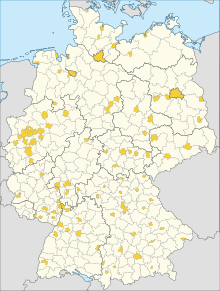
For the situation in Germany compare Kreise. Each administrative district consists of an elected council and an executive, and whose duties are comparable to those of a county executive in the United States, supervising local government administration. Historically, counties in the Holy Roman Empire were called Grafschaften.
Hungary
The administrative unit of Hungary is called megye (historically, they were also called vármegye; comitatus in Latin), which can be translated with the word county. The 19 counties constitute the highest level of the administrative subdivisions of the country together with the capital city Budapest, although counties and the capital are grouped into seven statistical regions.
Counties are subdivided to municipalities, the two types of which are towns and villages, each one having their own elected mayor and council. 23 of the towns have the rights of a county although they do not form independent territorial units equal to counties. Municipalities are grouped within counties into subregions (kistérség), which have statistical and organizational functions only.
The vármegye was also the historic administrative unit in the Kingdom of Hungary, which included areas of present-day neighbouring countries of Hungary. Its Latin name (comitatus) is the equivalent of the French comté. Actual political and administrative role of counties changed much through history. Originally they were subdivisions of the royal administration, but from the 13th century they became self-governments of the nobles and kept this character until the 19th century when in turn they became modern local governments.
Ireland

The island of Ireland was historically divided into 32 counties, of which 26 later formed the Republic of Ireland and 6 made up Northern Ireland.
These counties are traditionally grouped into four provinces: Leinster (12 counties), Munster (6) Connacht (5) and Ulster (9). Historically, the counties of Meath and Westmeath and small parts of surrounding counties constituted the province of Mide, which was one of the "Five Fifths" of Ireland (in the Irish language the word for province, cúige, means 'a fifth': from cúig, 'five'); however, these have long since become the three northernmost counties of Leinster province. In the Republic each county is administered by an elected "county council", and the old provincial divisions are merely traditional names with no political significance.
The number and boundaries of administrative counties in the Republic of Ireland were reformed in the 1990s. For example, County Dublin was divided into three: Dún Laoghaire–Rathdown, Fingal, and South Dublin; the City of Dublin had existed for centuries before. The cities of Cork and Galway have been separated from the town and rural areas of their counties. The cities of Limerick and Waterford were merged with their respective counties in 2014. Thus, the Republic of Ireland now has 31 'county-level' authorities, although the borders of the original twenty-six counties are still officially in place.[11]
In Northern Ireland, the six county councils and the smaller town councils were abolished in 1973 and replaced by a single tier of local government. However, in the north as well as in the south, the traditional 32 counties and 4 provinces remain in common usage for many sporting, cultural and other purposes. County identity is heavily reinforced in the local culture by allegiances to county teams in hurling and Gaelic football. Each Gaelic Athletic Association county has its own flag/colours (and often a nickname), and county allegiances are taken quite seriously. See the counties of Ireland and the Gaelic Athletic Association.
Italy
In Italy the word county is not used; the administrative sub-division of a region is called provincia. Italian provinces are mainly named after their principal town and comprise several administrative subdivisions called comuni ('communes'). There are currently 110 provinces in Italy.
In the context of pre-modern Italy, the Italian word contado generally refers to the countryside surrounding, and controlled by, the city state. The contado provided natural resources and agricultural products to sustain the urban population. In contemporary usage, contado can refer to a metropolitan area, and in some cases large rural/suburban regions providing resources to distant cities.[12]
Lithuania
Apskritis (plural apskritys) is the Lithuanian word for county. Since 1994 Lithuania has 10 counties; before 1950 it had 20. The only purpose with the county is an office of a state governor who shall conduct law and order in the county.
Norway
Norway has been divided into 11 counties (Bokmål: fylker, Nynorsk: fylke; singular: fylke) since 2020; they previously numbered 19 following a local government reform in 1972. Until that year Bergen was a separate county, but today it is a municipality within the county of Vestland. All counties form administrative entities called county municipalities (fylkeskommuner or fylkeskommunar; singular: fylkeskommune), further subdivided into municipalities (kommuner or kommunar; singular: kommune). One county, Oslo, is not divided into municipalities, rather it is equivalent to the municipality of Oslo.
Each county has its own county council (fylkesting) whose representatives are elected every four years together with representatives to the municipal councils. The counties handle matters such as high schools and local roads, and until 1 January 2002 hospitals as well. This last responsibility was transferred to the state-run health authorities and health trusts, and there is a debate on the future of the county municipality as an administrative entity. Some people, and parties, such as the Conservative and Progress Party, call for the abolition of the county municipalities once and for all, while others, including the Labour Party, merely want to merge some of them into larger regions.
Poland
A second-level administrative division in Poland is called a powiat. This is a subdivision of a voivodeship, or province, and is further subdivided into gminas. The term is often translated into English as county (or sometimes district).
Romania
Romania is divided into 41 jurisdictions; a jurisdiction is called a județ. The Romanian word for county, comitat, is not currently used for any Romanian administrative divisions.
Sweden
The Swedish division into counties was established in 1634, and was based on an earlier division into provinces; Sweden is today divided into 21 counties. At the county level there is a county administrative board led by a governor appointed by the central government of Sweden, as well as an elected county council that handles a separate set of issues, notably hospitals and public transportation for the municipalities within its borders. The Swedish term used is län, which literally means 'fief'.
United Kingdom
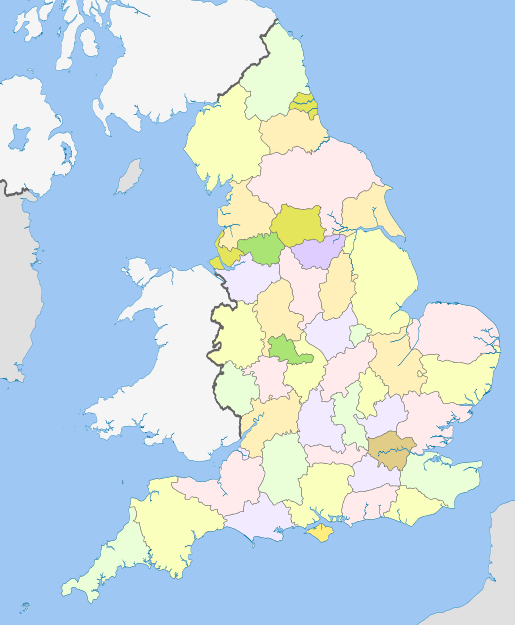
The United Kingdom is divided into a number of metropolitan and non-metropolitan counties. There are also ceremonial counties which group small non-metropolitan counties into geographical areas broadly based on the historic counties of England. In 1974, the metropolitan and non-metropolitan counties replaced the system of administrative counties and county boroughs which was introduced in 1889.
Most non-metropolitan counties in England are run by county councils and are divided into non-metropolitan districts, each with its own council. Local authorities in the UK are usually responsible for education, emergency services, planning, transport, social services, and a number of other functions.
In England, in the Anglo-Saxon period, shires were established as areas used for the raising of taxes, and usually had a fortified town at their centre. This became known as the shire town or later the county town. In many cases, the shires were named after their shire town (for example Bedfordshire), but there are several exceptions, such as Cumberland, Norfolk and Suffolk. In several other cases, such as Buckinghamshire, the modern county town is different from the town for which the shire is named. (See Toponymical list of counties of the United Kingdom)
The name "county" was introduced by the Normans, and was derived from a Norman term for an area administered by a Count (lord). These Norman "counties" were simply the Saxon shires, and kept their Saxon names. Several traditional counties, including Essex, Sussex and Kent, predate the unification of England by Alfred the Great, and were originally more or less independent kingdoms.
In Northern Ireland, the six county councils, if not their counties, were abolished in 1973 and replaced by 26 local government districts. The traditional six counties remain in common everyday use for many cultural and other purposes.
The thirteen historic counties of Wales were fixed by statute in 1539 (although counties such as Pembrokeshire date from 1138) and most of the shires of Scotland are of at least this age. In the Gaelic form, Scottish traditional county names are generally distinguished by the designation siorramachd—literally "sheriffdom", e.g. Siorramachd Earra-ghaidheal (Argyllshire). This term corresponds to the jurisdiction of the sheriff in the Scottish legal system.
Until 1974, the county boundaries of England changed little over time. In the medieval period, a number of important cities were granted the status of counties in their own right, such as London, Bristol and Coventry, and numerous small exclaves such as Islandshire were created. In 1844, most of these exclaves were transferred to their surrounding counties.
In 1965 and 1974–1975, major reorganisations of local government in England and Wales created several new administrative counties such as Hereford and Worcester and also created several new metropolitan counties based on large urban areas as a single administrative unit. In Scotland, county-level local government was replaced by larger regions, which lasted until 1996. Modern local government in Scotland, Wales, Northern Ireland and a large part of England is trending towards smaller unitary authorities: a system similar to that proposed in the 1960s by the Redcliffe-Maud Report for most of Britain.
Notes
- 1666 in the consolidation of Canada after the French and Indian War from the 1066 Norman Conquest... 600 yrs
- The larger the population center, and the denser the population, the more likely it is to have assumed and subsumed county level functions; normally under a special bill passed by the cognizant legislative body.
- National governments that are Federations, such as Germany have subdivisions similar to the English Counties in size. France has provinces and districts which similarly provide governmental services. Which services are mapped to which governmental offices, level or officials is the province of the national constitution and legislative body.
- e.g. Westmoreland, Washington in western Pennsylvania.
References
- Chambers Dictionary, L. Brookes (ed.), 2005, Chambers Harrap Publishers Ltd, Edinburgh
- The Oxford Dictionary of English Etymology, C. W. Onions (Ed.), 1966, Oxford University Press
- Vision of Britain — Type details for ancient county. Retrieved 31 March 2012
- "county". Etymology Online.
- "County Government" (PDF). Citizen's Guide to Pennsylvania Local Government: 8. 2010. Retrieved 9 August 2016.
The eleven elected county officers are enumerated in the Pennsylvania Constitution, but their powers and duties are prescribed by statutes located through out the county codes and general state laws. Consolidation of certain offices in smaller counties involves the offices of prothonotary, clerk of courts, register of wills and recorder of deeds.
- Province of Alberta. "Transitional Provisions, Consequential Amendments, Repeal and Commencement (Municipal Government Act)" (PDF). Archived from the original (PDF) on 23 January 2012. Retrieved 17 November 2010.
- "County and equivalent entity". factfinder.census.gov. Archived from the original on 22 March 2020. Retrieved 21 March 2020.
- "County Government" (PDF). Citizen's Guide to Pennsylvania Local Government: 8 of 56. 2010. Retrieved 9 August 2016.
- There were exceptions in the Jīn and Yuan dynasties, when cities were separated from counties and independently administered by institutions like 録事司 (lù shi sī) and 司候司 (sī hòu sī).
- "Amternes administration 1660–1970 (in Danish)". Dansk Center for Byhistorie. Archived from the original on 4 January 2010. Retrieved 1 January 2007.
- "Areas". Ordnance Survey Ireland. Archived from the original on 3 July 2007. Retrieved 1 July 2007.
- Guenzi, Alberto (2016). Guilds, Markets and Work Regulations in Italy, 16th–19th Centuries. Routledge. ISBN 9781351931960.
External links
| Look up county in Wiktionary, the free dictionary. |

